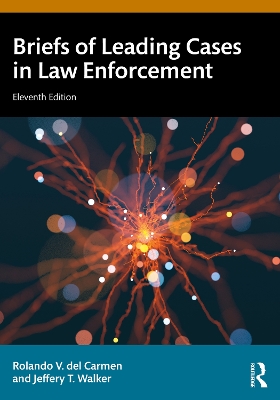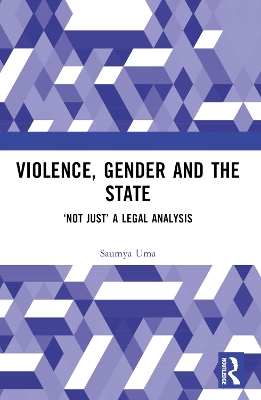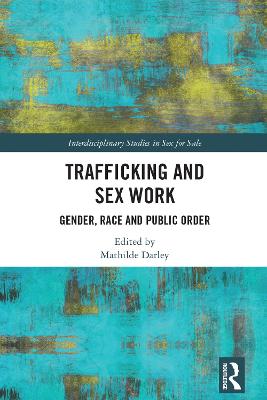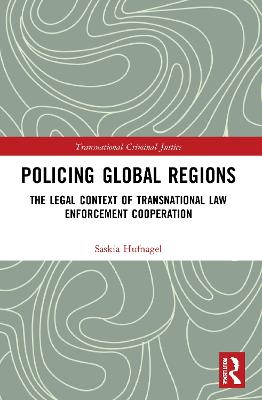Police Discretion in India
 portes grátis
portes grátis
Police Discretion in India
Legal and Extralegal Factors
Mohanty, Satyajit
Taylor & Francis Ltd
12/2024
206
Mole
9781032524344
Pré-lançamento - envio 15 a 20 dias após a sua edição
Descrição não disponível.
List of Figures xiii
List of Tables xiv
Foreword xvi
UPENDRA BAXI
Acknowledgements xx
Abbreviations xxi
Preface xxii
1 Introduction 1
1.1 The Background 1
1.2 Ground Reality of Arrests in India 3
1.3 The Determinants of Arrest Discretion 6
1.4 Explanation of Terms 7
1.5 Context of the Study 10
1.6 Purpose of the Study 13
1.7 Queries That Need to Be Answered 14
1.8 Academic Significance of the Study 15
2 Police Discretion: Factors Influencing Arrest Discretion 18
2.1 Police Discretion 18
2.2 The "Discovery of Discretion" and Subsequent Developments 20
2.3 Interpretation of Discretion by National Courts 23
2.4 Factors Influencing Arrest Discretion 27
2.5 Measuring the Factors Influencing Arrest Discretion 38
2.6 Key Hypotheses 39
2.7 A Diagrammatic Representation of Arrest Drivers 41
3 Police Discretion: Laws and Policies in India 44
3.1 From Regulation of 1772 to Police Act 1861 45
3.2 The Legacy of Police Act 1861 48
3.3 Development After Independence 48
3.4 Constitution of India 49
3.5 The National Police Commission (1977-1981) 51
3.6 Recommendations on Structural Changes 53
3.7 Prakash Singh Case on Police Reforms 54
3.8 National Human Rights Commission 54
3.9 The Supreme Court and High Courts of India on Police Discretion 55
3.10 The Supreme Court of India 57
3.11 Police Manual 61
3.12 Law Commission of India: 177th Report on Law Relating to Arrest 62
3.13 Arnesh Kumar 67
3.14 Rajesh Sharma 69
4 Measuring the Factors Influencing Arrest Discretion 73
4.1 Distilling the Drivers of Arrest Discretion 73
4.2 Operationalisation of Organisational Determinants 75
4.3 Operationalisation of Subculture Determinants 79
4.4 Operationalisation of Environmental Determinants 82
4.5 Operationalisation of Individual Determinants 85
4.6 Operationalisation of Situational/Offender Determinants 86
4.7 Variables or Indicators of Discretion 88
4.8 Translating Indicators to Response Statements 89
4.9 Sampling Technique 91
4.10 Data Collection 92
4.11 Data Analysis Techniques 93
5 The Interplay of Legal and Extralegal Factors in Police Discretion 96
5.1 Data Analysis and Findings 96
5.2 Sample Area for the Study 98
5.3 Analysis of Frequency Distribution 99
5.4 Subcultural Determinants 109
5.5 Environmental Determinants 111
5.6 Factors With Significant Contribution in Influencing Arrest Discretion 113
5.7 Degree of Influence of the Determinants on Arrest Discretion Behaviour 117
6 The Effects of Individual and Situational Factors on Arrest Discretion 120
6.1 Analysis of Individual Determinants 120
6.2 Individual Determinants: Gender, Experience and Position as Variables 120
6.3 Relative Impact of Individual Determinants 134
6.4 Data Analysis of Situational/Offenders' Determinants 135
6.5 Samples 136
6.6 Socio-Economic Status of Offenders as Variables 136
6.7 Awareness of Legal Rights 140
6.8 Legal Assistance 141
7 Conclusion: Findings and Recommendations 143
7.1 A Brief Summary 143
7.2 Key Findings 146
7.3 Organisational Determinants 146
7.4 Subcultural Determinants 148
7.5 Environmental Determinants 149
7.6 Relative Significance of the Independent Variables on Arrest Discretion 150
7.7 Subcultural Determinants 151
7.8 Environmental Determinants 152
7.9 Relative Significance of Organisational, Subcultural and Environmental Determinants Over Arrest
Discretion 152
7.10 Individual Determinants 153
7.11 Relative Significance Within Gender, Experience and
Position 154
7.12 Situational Determinants 154
7.13 Discussions on the Hypotheses 155
7.14 Discussions on the Questions That Need to Be Answered 158
7.15 Implications 163
7.16 Limitations 165
7.17 Recommendations 166
Appendix A: Number of Offences With Punishment Up to or Less Than Seven Years and More Than Seven Years in Indian Penal Code and Minor Criminal Acts 171
Appendix B: NHRC Guidelines Regarding Arrest 172
Appendix C: Interview Schedule for Odisha Police Officers 177
Appendix D: Interview Schedule 182
Appendix E: Interview Schedule for Offenders 186
Appendix F: Sampling Method of Officers From Odisha Police 188
Appendix G: Sample List of Field Police Administrative Units in the State (Selected by Adopting SRSWOR) 189
Appendix H: Explanatory Note on How to Fill Up the Written Interview Schedule 191
Appendix I: District-Wise Respondents of Odisha Police 194
Appendix J: Number of Respondent IPS Officers With Cadre 195
Appendix K: Sample Details for the Situational Determinants 196
Appendix L: Check List 197
References 198
Index 203
List of Tables xiv
Foreword xvi
UPENDRA BAXI
Acknowledgements xx
Abbreviations xxi
Preface xxii
1 Introduction 1
1.1 The Background 1
1.2 Ground Reality of Arrests in India 3
1.3 The Determinants of Arrest Discretion 6
1.4 Explanation of Terms 7
1.5 Context of the Study 10
1.6 Purpose of the Study 13
1.7 Queries That Need to Be Answered 14
1.8 Academic Significance of the Study 15
2 Police Discretion: Factors Influencing Arrest Discretion 18
2.1 Police Discretion 18
2.2 The "Discovery of Discretion" and Subsequent Developments 20
2.3 Interpretation of Discretion by National Courts 23
2.4 Factors Influencing Arrest Discretion 27
2.5 Measuring the Factors Influencing Arrest Discretion 38
2.6 Key Hypotheses 39
2.7 A Diagrammatic Representation of Arrest Drivers 41
3 Police Discretion: Laws and Policies in India 44
3.1 From Regulation of 1772 to Police Act 1861 45
3.2 The Legacy of Police Act 1861 48
3.3 Development After Independence 48
3.4 Constitution of India 49
3.5 The National Police Commission (1977-1981) 51
3.6 Recommendations on Structural Changes 53
3.7 Prakash Singh Case on Police Reforms 54
3.8 National Human Rights Commission 54
3.9 The Supreme Court and High Courts of India on Police Discretion 55
3.10 The Supreme Court of India 57
3.11 Police Manual 61
3.12 Law Commission of India: 177th Report on Law Relating to Arrest 62
3.13 Arnesh Kumar 67
3.14 Rajesh Sharma 69
4 Measuring the Factors Influencing Arrest Discretion 73
4.1 Distilling the Drivers of Arrest Discretion 73
4.2 Operationalisation of Organisational Determinants 75
4.3 Operationalisation of Subculture Determinants 79
4.4 Operationalisation of Environmental Determinants 82
4.5 Operationalisation of Individual Determinants 85
4.6 Operationalisation of Situational/Offender Determinants 86
4.7 Variables or Indicators of Discretion 88
4.8 Translating Indicators to Response Statements 89
4.9 Sampling Technique 91
4.10 Data Collection 92
4.11 Data Analysis Techniques 93
5 The Interplay of Legal and Extralegal Factors in Police Discretion 96
5.1 Data Analysis and Findings 96
5.2 Sample Area for the Study 98
5.3 Analysis of Frequency Distribution 99
5.4 Subcultural Determinants 109
5.5 Environmental Determinants 111
5.6 Factors With Significant Contribution in Influencing Arrest Discretion 113
5.7 Degree of Influence of the Determinants on Arrest Discretion Behaviour 117
6 The Effects of Individual and Situational Factors on Arrest Discretion 120
6.1 Analysis of Individual Determinants 120
6.2 Individual Determinants: Gender, Experience and Position as Variables 120
6.3 Relative Impact of Individual Determinants 134
6.4 Data Analysis of Situational/Offenders' Determinants 135
6.5 Samples 136
6.6 Socio-Economic Status of Offenders as Variables 136
6.7 Awareness of Legal Rights 140
6.8 Legal Assistance 141
7 Conclusion: Findings and Recommendations 143
7.1 A Brief Summary 143
7.2 Key Findings 146
7.3 Organisational Determinants 146
7.4 Subcultural Determinants 148
7.5 Environmental Determinants 149
7.6 Relative Significance of the Independent Variables on Arrest Discretion 150
7.7 Subcultural Determinants 151
7.8 Environmental Determinants 152
7.9 Relative Significance of Organisational, Subcultural and Environmental Determinants Over Arrest
Discretion 152
7.10 Individual Determinants 153
7.11 Relative Significance Within Gender, Experience and
Position 154
7.12 Situational Determinants 154
7.13 Discussions on the Hypotheses 155
7.14 Discussions on the Questions That Need to Be Answered 158
7.15 Implications 163
7.16 Limitations 165
7.17 Recommendations 166
Appendix A: Number of Offences With Punishment Up to or Less Than Seven Years and More Than Seven Years in Indian Penal Code and Minor Criminal Acts 171
Appendix B: NHRC Guidelines Regarding Arrest 172
Appendix C: Interview Schedule for Odisha Police Officers 177
Appendix D: Interview Schedule 182
Appendix E: Interview Schedule for Offenders 186
Appendix F: Sampling Method of Officers From Odisha Police 188
Appendix G: Sample List of Field Police Administrative Units in the State (Selected by Adopting SRSWOR) 189
Appendix H: Explanatory Note on How to Fill Up the Written Interview Schedule 191
Appendix I: District-Wise Respondents of Odisha Police 194
Appendix J: Number of Respondent IPS Officers With Cadre 195
Appendix K: Sample Details for the Situational Determinants 196
Appendix L: Check List 197
References 198
Index 203
Este título pertence ao(s) assunto(s) indicados(s). Para ver outros títulos clique no assunto desejado.
police discretion;Arrest;police system in India;Extralegal Factors;Human Rights;Human Rights and Police;Arrest Discretion;Human Rights in India;Arrest Decisions;Organisational Determinants;Police Subculture;Environmental Determinants;Law Commission;Supervisory Officers;Discretionary Abuse;National Police Commission;Indian Police Service;Court Directives;Arrest Procedures;Individual Determinants;Arrest Law;Situational Determinant;Internal Review Mechanism;Police Organisations;Civil Society;Literature Review;Bailable Offences;Strongly Agree;Arrest Figures;Legislative Intent
List of Figures xiii
List of Tables xiv
Foreword xvi
UPENDRA BAXI
Acknowledgements xx
Abbreviations xxi
Preface xxii
1 Introduction 1
1.1 The Background 1
1.2 Ground Reality of Arrests in India 3
1.3 The Determinants of Arrest Discretion 6
1.4 Explanation of Terms 7
1.5 Context of the Study 10
1.6 Purpose of the Study 13
1.7 Queries That Need to Be Answered 14
1.8 Academic Significance of the Study 15
2 Police Discretion: Factors Influencing Arrest Discretion 18
2.1 Police Discretion 18
2.2 The "Discovery of Discretion" and Subsequent Developments 20
2.3 Interpretation of Discretion by National Courts 23
2.4 Factors Influencing Arrest Discretion 27
2.5 Measuring the Factors Influencing Arrest Discretion 38
2.6 Key Hypotheses 39
2.7 A Diagrammatic Representation of Arrest Drivers 41
3 Police Discretion: Laws and Policies in India 44
3.1 From Regulation of 1772 to Police Act 1861 45
3.2 The Legacy of Police Act 1861 48
3.3 Development After Independence 48
3.4 Constitution of India 49
3.5 The National Police Commission (1977-1981) 51
3.6 Recommendations on Structural Changes 53
3.7 Prakash Singh Case on Police Reforms 54
3.8 National Human Rights Commission 54
3.9 The Supreme Court and High Courts of India on Police Discretion 55
3.10 The Supreme Court of India 57
3.11 Police Manual 61
3.12 Law Commission of India: 177th Report on Law Relating to Arrest 62
3.13 Arnesh Kumar 67
3.14 Rajesh Sharma 69
4 Measuring the Factors Influencing Arrest Discretion 73
4.1 Distilling the Drivers of Arrest Discretion 73
4.2 Operationalisation of Organisational Determinants 75
4.3 Operationalisation of Subculture Determinants 79
4.4 Operationalisation of Environmental Determinants 82
4.5 Operationalisation of Individual Determinants 85
4.6 Operationalisation of Situational/Offender Determinants 86
4.7 Variables or Indicators of Discretion 88
4.8 Translating Indicators to Response Statements 89
4.9 Sampling Technique 91
4.10 Data Collection 92
4.11 Data Analysis Techniques 93
5 The Interplay of Legal and Extralegal Factors in Police Discretion 96
5.1 Data Analysis and Findings 96
5.2 Sample Area for the Study 98
5.3 Analysis of Frequency Distribution 99
5.4 Subcultural Determinants 109
5.5 Environmental Determinants 111
5.6 Factors With Significant Contribution in Influencing Arrest Discretion 113
5.7 Degree of Influence of the Determinants on Arrest Discretion Behaviour 117
6 The Effects of Individual and Situational Factors on Arrest Discretion 120
6.1 Analysis of Individual Determinants 120
6.2 Individual Determinants: Gender, Experience and Position as Variables 120
6.3 Relative Impact of Individual Determinants 134
6.4 Data Analysis of Situational/Offenders' Determinants 135
6.5 Samples 136
6.6 Socio-Economic Status of Offenders as Variables 136
6.7 Awareness of Legal Rights 140
6.8 Legal Assistance 141
7 Conclusion: Findings and Recommendations 143
7.1 A Brief Summary 143
7.2 Key Findings 146
7.3 Organisational Determinants 146
7.4 Subcultural Determinants 148
7.5 Environmental Determinants 149
7.6 Relative Significance of the Independent Variables on Arrest Discretion 150
7.7 Subcultural Determinants 151
7.8 Environmental Determinants 152
7.9 Relative Significance of Organisational, Subcultural and Environmental Determinants Over Arrest
Discretion 152
7.10 Individual Determinants 153
7.11 Relative Significance Within Gender, Experience and
Position 154
7.12 Situational Determinants 154
7.13 Discussions on the Hypotheses 155
7.14 Discussions on the Questions That Need to Be Answered 158
7.15 Implications 163
7.16 Limitations 165
7.17 Recommendations 166
Appendix A: Number of Offences With Punishment Up to or Less Than Seven Years and More Than Seven Years in Indian Penal Code and Minor Criminal Acts 171
Appendix B: NHRC Guidelines Regarding Arrest 172
Appendix C: Interview Schedule for Odisha Police Officers 177
Appendix D: Interview Schedule 182
Appendix E: Interview Schedule for Offenders 186
Appendix F: Sampling Method of Officers From Odisha Police 188
Appendix G: Sample List of Field Police Administrative Units in the State (Selected by Adopting SRSWOR) 189
Appendix H: Explanatory Note on How to Fill Up the Written Interview Schedule 191
Appendix I: District-Wise Respondents of Odisha Police 194
Appendix J: Number of Respondent IPS Officers With Cadre 195
Appendix K: Sample Details for the Situational Determinants 196
Appendix L: Check List 197
References 198
Index 203
List of Tables xiv
Foreword xvi
UPENDRA BAXI
Acknowledgements xx
Abbreviations xxi
Preface xxii
1 Introduction 1
1.1 The Background 1
1.2 Ground Reality of Arrests in India 3
1.3 The Determinants of Arrest Discretion 6
1.4 Explanation of Terms 7
1.5 Context of the Study 10
1.6 Purpose of the Study 13
1.7 Queries That Need to Be Answered 14
1.8 Academic Significance of the Study 15
2 Police Discretion: Factors Influencing Arrest Discretion 18
2.1 Police Discretion 18
2.2 The "Discovery of Discretion" and Subsequent Developments 20
2.3 Interpretation of Discretion by National Courts 23
2.4 Factors Influencing Arrest Discretion 27
2.5 Measuring the Factors Influencing Arrest Discretion 38
2.6 Key Hypotheses 39
2.7 A Diagrammatic Representation of Arrest Drivers 41
3 Police Discretion: Laws and Policies in India 44
3.1 From Regulation of 1772 to Police Act 1861 45
3.2 The Legacy of Police Act 1861 48
3.3 Development After Independence 48
3.4 Constitution of India 49
3.5 The National Police Commission (1977-1981) 51
3.6 Recommendations on Structural Changes 53
3.7 Prakash Singh Case on Police Reforms 54
3.8 National Human Rights Commission 54
3.9 The Supreme Court and High Courts of India on Police Discretion 55
3.10 The Supreme Court of India 57
3.11 Police Manual 61
3.12 Law Commission of India: 177th Report on Law Relating to Arrest 62
3.13 Arnesh Kumar 67
3.14 Rajesh Sharma 69
4 Measuring the Factors Influencing Arrest Discretion 73
4.1 Distilling the Drivers of Arrest Discretion 73
4.2 Operationalisation of Organisational Determinants 75
4.3 Operationalisation of Subculture Determinants 79
4.4 Operationalisation of Environmental Determinants 82
4.5 Operationalisation of Individual Determinants 85
4.6 Operationalisation of Situational/Offender Determinants 86
4.7 Variables or Indicators of Discretion 88
4.8 Translating Indicators to Response Statements 89
4.9 Sampling Technique 91
4.10 Data Collection 92
4.11 Data Analysis Techniques 93
5 The Interplay of Legal and Extralegal Factors in Police Discretion 96
5.1 Data Analysis and Findings 96
5.2 Sample Area for the Study 98
5.3 Analysis of Frequency Distribution 99
5.4 Subcultural Determinants 109
5.5 Environmental Determinants 111
5.6 Factors With Significant Contribution in Influencing Arrest Discretion 113
5.7 Degree of Influence of the Determinants on Arrest Discretion Behaviour 117
6 The Effects of Individual and Situational Factors on Arrest Discretion 120
6.1 Analysis of Individual Determinants 120
6.2 Individual Determinants: Gender, Experience and Position as Variables 120
6.3 Relative Impact of Individual Determinants 134
6.4 Data Analysis of Situational/Offenders' Determinants 135
6.5 Samples 136
6.6 Socio-Economic Status of Offenders as Variables 136
6.7 Awareness of Legal Rights 140
6.8 Legal Assistance 141
7 Conclusion: Findings and Recommendations 143
7.1 A Brief Summary 143
7.2 Key Findings 146
7.3 Organisational Determinants 146
7.4 Subcultural Determinants 148
7.5 Environmental Determinants 149
7.6 Relative Significance of the Independent Variables on Arrest Discretion 150
7.7 Subcultural Determinants 151
7.8 Environmental Determinants 152
7.9 Relative Significance of Organisational, Subcultural and Environmental Determinants Over Arrest
Discretion 152
7.10 Individual Determinants 153
7.11 Relative Significance Within Gender, Experience and
Position 154
7.12 Situational Determinants 154
7.13 Discussions on the Hypotheses 155
7.14 Discussions on the Questions That Need to Be Answered 158
7.15 Implications 163
7.16 Limitations 165
7.17 Recommendations 166
Appendix A: Number of Offences With Punishment Up to or Less Than Seven Years and More Than Seven Years in Indian Penal Code and Minor Criminal Acts 171
Appendix B: NHRC Guidelines Regarding Arrest 172
Appendix C: Interview Schedule for Odisha Police Officers 177
Appendix D: Interview Schedule 182
Appendix E: Interview Schedule for Offenders 186
Appendix F: Sampling Method of Officers From Odisha Police 188
Appendix G: Sample List of Field Police Administrative Units in the State (Selected by Adopting SRSWOR) 189
Appendix H: Explanatory Note on How to Fill Up the Written Interview Schedule 191
Appendix I: District-Wise Respondents of Odisha Police 194
Appendix J: Number of Respondent IPS Officers With Cadre 195
Appendix K: Sample Details for the Situational Determinants 196
Appendix L: Check List 197
References 198
Index 203
Este título pertence ao(s) assunto(s) indicados(s). Para ver outros títulos clique no assunto desejado.
police discretion;Arrest;police system in India;Extralegal Factors;Human Rights;Human Rights and Police;Arrest Discretion;Human Rights in India;Arrest Decisions;Organisational Determinants;Police Subculture;Environmental Determinants;Law Commission;Supervisory Officers;Discretionary Abuse;National Police Commission;Indian Police Service;Court Directives;Arrest Procedures;Individual Determinants;Arrest Law;Situational Determinant;Internal Review Mechanism;Police Organisations;Civil Society;Literature Review;Bailable Offences;Strongly Agree;Arrest Figures;Legislative Intent







